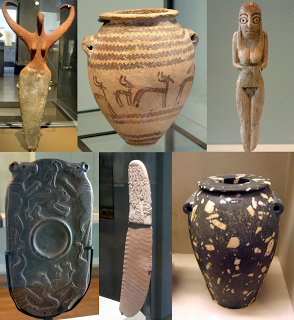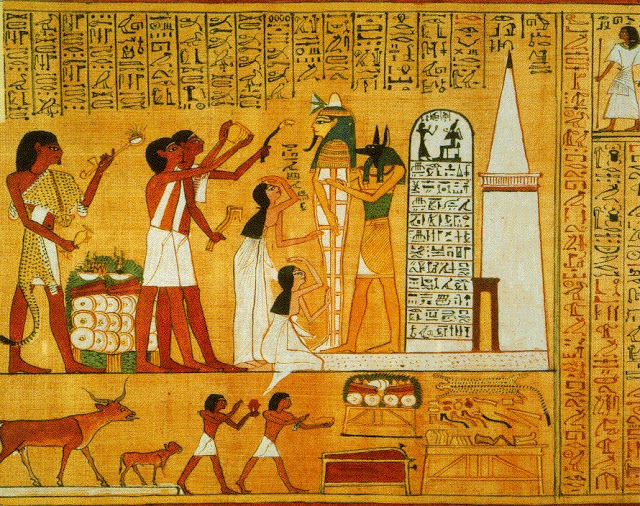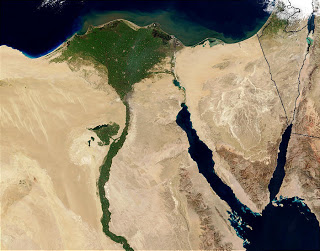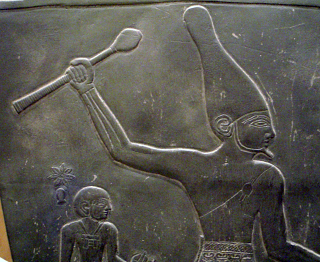Medieval History
The thing about history is that it continually starts with one culture and then fades into a different one over and over again, but you knew this already to some extent. My point is that it is very important to know the significance of several cultures during the early and late Bronze Age, since these cultures affected each other a great deal as power and trade dynamics shifted. After this article, the next best place to begin is in my other article Empire of the Hittites: Bronze Age Warriors since the glory of Egypt is revealed in its later years at the end of the bronze age when they came out of seclusion (around 1450s B.C. with Thutmose III's empire) and almost immediately entered into a war with the neighboring superpower known as the Hittites in the largest Bronze Age war ever. No wonder they stayed in isolation! This led into the first dark age when the Sea Peoples attacked but thankfully classical Greece popped on the scene some decades after the devastation, which is also described in detail in my articles "Lacedaemonians and Athenians: Battles at Thermopylae and Salamis" and "The Greek Golden Age and the Great Peloponnesian War." Both articles take from the two most pivotal moments in Greek history, describing how the Athenians and Spartans took their places in history forever by ushering in a new era. Any historian will tell you that you can know all the cultures and ages, but every age is led by one culture...and those are the cultures who shape the world.
 Proto-Egypt: The Egypt you know of now actually began with the Tasian and Amratian nomadic hunter-gatherer peoples coming to inhabit northern and southern Egypt, and overlapping in time periods. This is a little confusing so read carefully! It is thought that the Tasians and Badarians, two separate cultures, began at different times but were so similar that it's not clear if they truly were separate. The Tasians came to northern Egypt around perhaps around 4500 B.C. some say, but any actual dates are speculative at best. These Tasians became the Badarians. Simultaneously around 4400 B.C., in southern proto-Egypt the Amratians eventually became the Gerzeans through intermingling also, and those two cultures in the north and south began trading. By around 4000 B.C. both cultures intermingled to such a high degree that beyond this point historians simply call them all proto-Egyptians.
Proto-Egypt: The Egypt you know of now actually began with the Tasian and Amratian nomadic hunter-gatherer peoples coming to inhabit northern and southern Egypt, and overlapping in time periods. This is a little confusing so read carefully! It is thought that the Tasians and Badarians, two separate cultures, began at different times but were so similar that it's not clear if they truly were separate. The Tasians came to northern Egypt around perhaps around 4500 B.C. some say, but any actual dates are speculative at best. These Tasians became the Badarians. Simultaneously around 4400 B.C., in southern proto-Egypt the Amratians eventually became the Gerzeans through intermingling also, and those two cultures in the north and south began trading. By around 4000 B.C. both cultures intermingled to such a high degree that beyond this point historians simply call them all proto-Egyptians.
Egypt is perhaps the most mystical and famed of all civilizations to ever take root on the Earth and probably had the most stable (yet isolated) existence of any culture on Earth. Egyptian history is fairly uneventful and dull until they dropped their xenophobic lifestyle around the 1460s with Queen Hatshepsut, sister of Thutmose III described in my article Empires of the Hittites, Hurrians, and Middle Egypt: Bronze Age Superpowers. Their overall stability most likely came from their desire for complete isolation and their pharaoh system of leadership, where the pharaohs were revered as gods in human flesh. Ancient Egypt itself was very nearly xenophobic, and they even believed that if they died outside of Egypt's borders they would not go to heaven with their Egyptian gods, so virtually no one ever left and little to no contact was ever maintained with other cultures. But what about the pharaohs? Well, the pharaohs began as a charade. Yes, you read that correctly. Around 3100 B.C. Egypt became what you know it to have been because a con-artist named Narmer Menes pretended to be a god. The story says that he learned how to measure the rising and falling of the mighty Nile River, the heart of Egypt and the cause of its wonderful soil and perfect crops.
Each year or so the Nile had a great flood, and many miles of soil run-off and sediment from down river (the river flows from south to north) would wash off and flow up to the northern parts of Egypt. The decayed plant matter and dead animal matter were truly a nutrient rich plant-food and would wash onto the Egyptian soil during the floods and soak into the land, which actually gave Egypt the best, fullest harvest of any country probably until better plows were invented in Medieval Europe thousands of years later. The soil was so soft and rich in nutrients that it is believed by historians that the Egyptians simply had to drop seeds on the ground to plant their crops, and no digging or plowing or tilling was ever required. Truly effortless. This is why the Nile River became a symbol of Egypt, since it gave them such a prosperous and easy life. Agriculture for the Egyptians was as simple as walking on a field and tossing seeds. Remember the last time you planted a flower in your garden? You had to dig a whole 6 inches deep, drop the plant or seeds in, cover it up and then water it. In ancient days, doing this on a agricultural scale was horrendous work until the plow was invented, which made Egypt truly famous for their soil and crops.?
Narmer Menes learned how to measure and predict the floods by a series of marks at specific points along the river, and around 3100 B.C., he gathered the leaders of the not-yet-unified Egyptian civilization to demonstrate his god-hood. At this point Egypt was nothing more than tiny villages in huts. Narmer claimed that he was a god-man, so to speak, or to say it another way, that he was inhabited but the spirit of a god in human flesh whose purpose was to unite and rule Egypt. He said that if they made him the leader of their villages then he would bless the Nile and make it flood to help the harvests in Egypt. This was clever, since a better harvest meant more crops and more prosperity in general. When the leaders of the scattered proto-Egyptian villages saw that the floods rose high on the day he said-- they believed he was a god and made him pharaoh of the new united Egypt. This is how the pharaohs were born. Northern and southern Egypt were unified under Narmer Menes along the Nile, and thus began Egypt's Old Kingdom dynasties
- New Dictionary On Ancient Egyptian Language Completes 37-year Project
A dictionary of thousands of words chronicling the everyday lives of people in ancient Egypt ? including what taxes they paid, what they expected in a marriage and how much work they had to do for the government ? has been completed by scholars at the...
- Ancient Egyptian Cotton Unveils Secrets Of Agricultural Evolution
Scientists studying 1,600-year-old cotton from the banks of the Nile have found what they believe is the first evidence that punctuated evolution has occurred in a major crop group within the relatively short history of plant domestication. The findings...
- Archaeologists Begin Restoring Ancient Boat Near Pyramids
Archaeologists on Monday began restoration on a 4,500-year-old wooden boat found next to the pyramids, one of Egypt's main tourist attractions. The boat is one of two that were buried next to the Pharaoh Khufu, spokesmen for a joint Egyptian-Japanese...
- Egypt's Man From The Past Who Insists He Has A Future
No one interviews Zahi Hawass, Egypt's self-styled Indiana Jones of the east ? he interviews himself, fist pounding on desk and spittle flying forth into the ether. "Do I look like a minister to you? Of course not!" thunders the minister for antiquities,...
- Empire Of The Hittites: Battling The Hurrians And Middle Egypt-- Bronze Age Superpowers
My other blogs are:http://religion-by-kyle.blogspot.comhttp://astronomy-by-kyle.blogspot.comEmpire of the Hittites Battling the Hurrians and Middle Egypt Bronze Age Superpowers This is highly detailed article of the Hittites (or Hatti) specifically taken...
Medieval History
Ancient Egypt: Narmer Menes and the Rise of the Pharoahs
My other blogs are:
http://religion-by-kyle.blogspot.com
http://astronomy-by-kyle.blogspot.com
 |
| The Rise of Ancient Egypt Narmer Menes 3100 B.C. A Brief Essay on the Birth of Egypt |

Egypt is perhaps the most mystical and famed of all civilizations to ever take root on the Earth and probably had the most stable (yet isolated) existence of any culture on Earth. Egyptian history is fairly uneventful and dull until they dropped their xenophobic lifestyle around the 1460s with Queen Hatshepsut, sister of Thutmose III described in my article Empires of the Hittites, Hurrians, and Middle Egypt: Bronze Age Superpowers. Their overall stability most likely came from their desire for complete isolation and their pharaoh system of leadership, where the pharaohs were revered as gods in human flesh. Ancient Egypt itself was very nearly xenophobic, and they even believed that if they died outside of Egypt's borders they would not go to heaven with their Egyptian gods, so virtually no one ever left and little to no contact was ever maintained with other cultures. But what about the pharaohs? Well, the pharaohs began as a charade. Yes, you read that correctly. Around 3100 B.C. Egypt became what you know it to have been because a con-artist named Narmer Menes pretended to be a god. The story says that he learned how to measure the rising and falling of the mighty Nile River, the heart of Egypt and the cause of its wonderful soil and perfect crops.
 |
| The Nile River Valley is the dark green strip. The river is mostly covered by the lush plant life it provides from its waters. The dark blue water to the right is the Red Sea |
 |
| Depiction of Narmer |
- New Dictionary On Ancient Egyptian Language Completes 37-year Project
A dictionary of thousands of words chronicling the everyday lives of people in ancient Egypt ? including what taxes they paid, what they expected in a marriage and how much work they had to do for the government ? has been completed by scholars at the...
- Ancient Egyptian Cotton Unveils Secrets Of Agricultural Evolution
Scientists studying 1,600-year-old cotton from the banks of the Nile have found what they believe is the first evidence that punctuated evolution has occurred in a major crop group within the relatively short history of plant domestication. The findings...
- Archaeologists Begin Restoring Ancient Boat Near Pyramids
Archaeologists on Monday began restoration on a 4,500-year-old wooden boat found next to the pyramids, one of Egypt's main tourist attractions. The boat is one of two that were buried next to the Pharaoh Khufu, spokesmen for a joint Egyptian-Japanese...
- Egypt's Man From The Past Who Insists He Has A Future
No one interviews Zahi Hawass, Egypt's self-styled Indiana Jones of the east ? he interviews himself, fist pounding on desk and spittle flying forth into the ether. "Do I look like a minister to you? Of course not!" thunders the minister for antiquities,...
- Empire Of The Hittites: Battling The Hurrians And Middle Egypt-- Bronze Age Superpowers
My other blogs are:http://religion-by-kyle.blogspot.comhttp://astronomy-by-kyle.blogspot.comEmpire of the Hittites Battling the Hurrians and Middle Egypt Bronze Age Superpowers This is highly detailed article of the Hittites (or Hatti) specifically taken...
